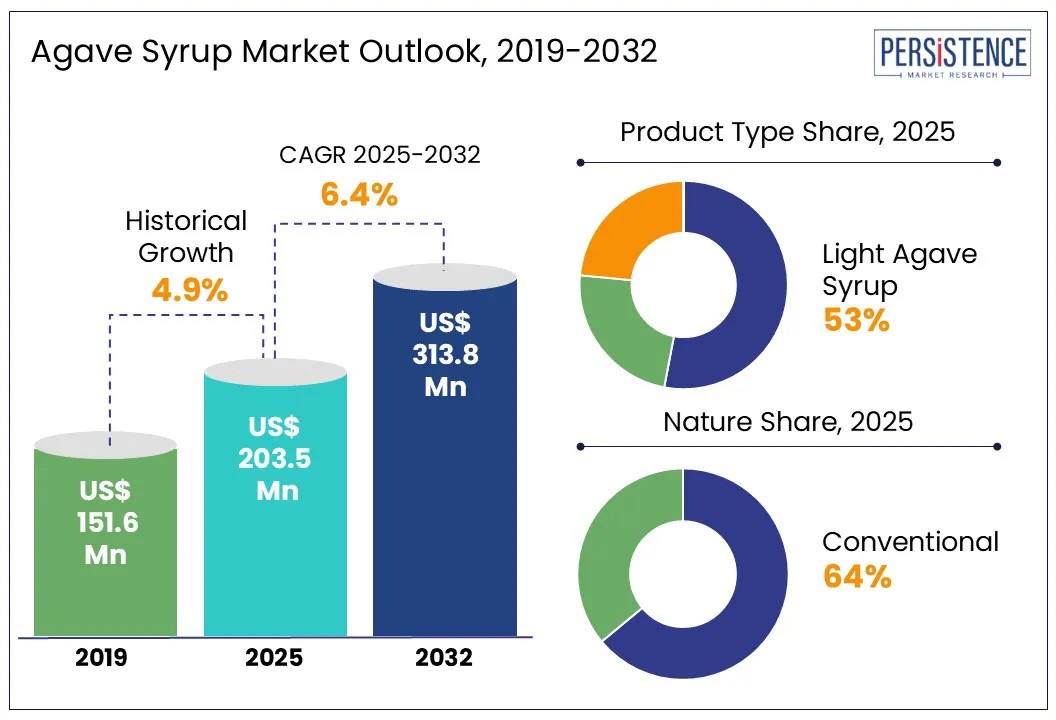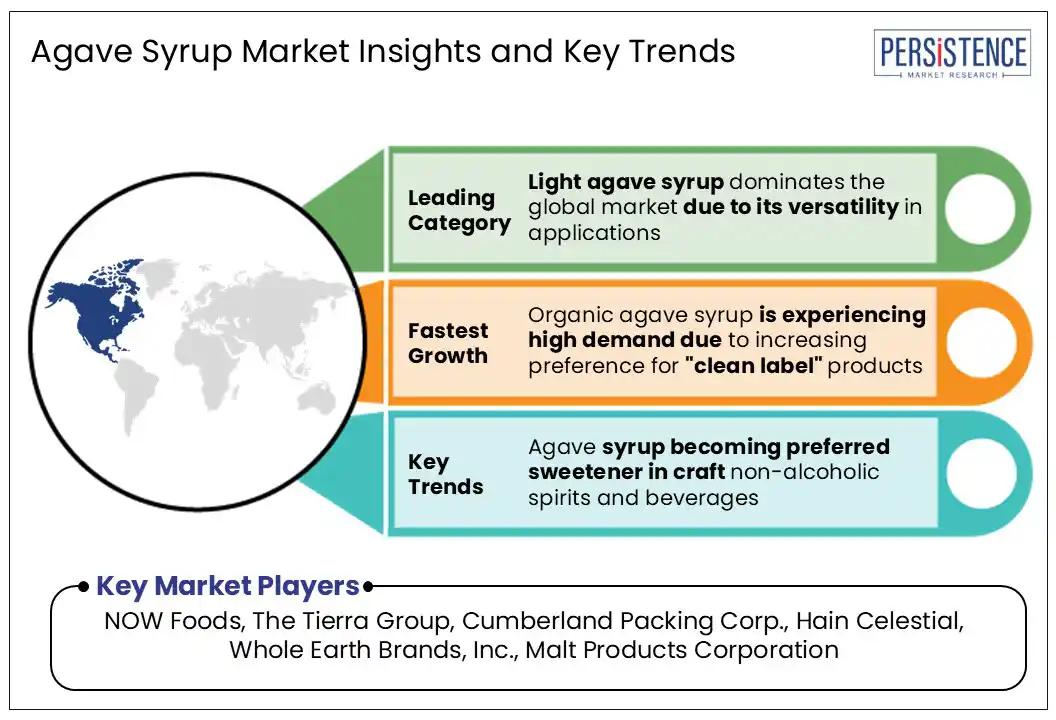ID: PMRREP16882| 197 Pages | 25 Jun 2025 | Format: PDF, Excel, PPT* | Food and Beverages

The global agave syrup market size is likely to grow US$ 203.5 million in 2025 and is expected to reach US$ 313.8 million by 2032, growing at a CAGR of 6.4% during the forecast period from 2025 to 2032.
According to Persistence Market Research, the agave syrup market is evolving beyond conventional sweetening, driven by rising demand for clean-label, low-glycemic alternatives. Emerging applications in craft beverages, functional foods, and vegan products are expanding its footprint, while supply-side innovations and regional cultivation strategies are shaping future market dynamics.

Key Industry Highlights:
|
Global Market Attribute |
Key Insights |
|
Global Agave Syrup Market Size (2025E) |
US$ 203.5 Mn |
|
Market Value Forecast (2032F) |
US$ 313.8 Mn |
|
Projected Growth (CAGR 2025 to 2032) |
6.4% |
|
Historical Market Growth (CAGR 2019 to 2024) |
4.9% |
The growing consumer demand for natural and organic sweeteners is a significant factor driving growth in the global agave syrup market. As health consciousness increases, consumers are moving away from refined sugars and high-fructose corn syrup. They are instead favoring plant-based, low-glycemic alternatives such as agave syrup. This shift is strongly influenced by the growing prevalence of diabetes. The International Diabetes Federation reports that approximately 589 million adults (aged 20–79) are living with diabetes globally as of 2024. This number is projected to surge to 853 million by 2050. In this context, agave syrup's low glycemic index and natural origin make it an attractive choice for consumers managing blood sugar levels or seeking preventive dietary solutions. Additionally, clean-label trends and the demand for transparent ingredient sourcing are prompting food and beverage manufacturers to incorporate organic agave syrup into their formulations. This positions agave as a strategic sweetening solution across functional foods, beverages, and health-focused categories.
Agave plants typically require 6 to 8 years to mature before they can be harvested for syrup production. This long cultivation cycle makes it difficult for producers to quickly scale supply when market demand rises.
Unlike synthetic sweeteners or fast-growing crops like sugarcane, agave's biological limitations hinder immediate production increases. Additionally, adverse weather events, competition for land use, and crop diseases further constrain yield predictability. As consumer interest in natural sweeteners grows especially in the health and wellness sectors the lag in supply adjustment creates pricing volatility and sourcing uncertainty for manufacturers. This structural inflexibility presents a significant challenge to sustained, scalable market growth.
Partnering with restaurants, cafes, and bakeries offers a high-impact opportunity for agave syrup producers to drive adoption and enhance visibility. As foodservice establishments respond to growing consumer demand for natural, low-glycemic sweeteners, integrating agave syrup into menus enables immediate product trials and consumer education. Consider artisan coffee shops offering agave-sweetened lattes, or bakeries replacing refined sugar in pastries. These collaborations effectively cater to consumer needs through direct and experience-based engagement.
A particular example is Starbucks, which introduced agave syrup as a customizable sweetener option in select markets, leveraging rising interest in plant-based and diabetic-friendly alternatives. Such partnerships expand agave’s presence beyond traditional retail and normalize its use in mainstream culinary experiences. For producers, working directly with chefs and foodservice innovators can spur product innovation, increase volume demand, and reinforce agave syrup’s image as a premium, health-conscious sweetener. This strategic alignment can foster brand differentiation and long-term consumer loyalty in an increasingly health-aware market.
Light agave syrup holds approximately 53% of the market share in 2024, making it the dominant product type in the global agave syrup market. Its mild flavor profile, light color, and high solubility make it exceptionally versatile for a wide range of applications—from sweetening beverages, cereals, and salad dressings to use in clean-label snacks and wellness products. Its ability to blend seamlessly without altering the taste or appearance of the final product appeals to both food manufacturers and home consumers alike.
In comparison, amber agave syrup offers a more robust, caramel-like flavor and is often favored in baking and marinades. Dark agave syrup, with its intense, molasses-like notes, is typically used in savory sauces or bold-flavored desserts. While these variants are gaining niche appeal, light agave syrup continues to dominate due to its broad functional adaptability and consumer preference for neutral-tasting natural sweeteners.
Organic agave syrup is expected to grow at a CAGR of 8.1% during the forecast period 2025 to 2032, driven by a significant shift in consumer behavior toward clean-label and transparently sourced food products. As health-conscious consumers increasingly scrutinize ingredient lists, demand is rising for natural sweeteners that are organic, non-GMO, and free from synthetic additives or pesticides. Organic agave syrup, derived from certified agave plants without chemical fertilizers or refining agents, aligns perfectly with this trend. Its low glycemic index and vegan-friendly profile further strengthen its appeal across the health food, beverage, and bakery segments. Manufacturers are leveraging this preference by integrating organic agave syrup into functional foods, energy bars, and plant-based dairy alternatives. Retailers are also expanding shelf space for certified organic sweeteners, particularly in North America and Western Europe, where clean label awareness is reshaping product formulation and purchase decisions across all major food categories.

North America commands a significant 36% value market share in the global agave syrup market. This strong position is supported by robust health trends, well-developed food processing infrastructure, and geographic advantages. The U.S. benefits from its proximity to Mexico, the primary source of agave, which ensures a more stable and responsive supply chain. Additionally, some states, like California, have seen localized agave cultivation, boosting domestic supply resilience. The region's vast food and beverage manufacturing sector increasingly incorporates agave syrup into various applications, from bakery goods to beverages, thanks to its clean label status and low glycemic index.
In Canada, consumer preferences are shifting sharply toward organic and naturally sourced sweeteners, positioning agave as a preferred alternative to traditional sugars. The rising popularity of specialty diets, including vegan, keto, and gluten-free, further enhances market potential. Moreover, craft beverage makers are exploring agave syrup for its nuanced flavor, integrating it into artisanal spirits and non-alcoholic beverages. Education on the glycemic index is also heightening agave's health-driven appeal across North America.
Latin America, especially Mexico, is at the heart of global agave cultivation and syrup production, making the region a critical supply base. While a substantial share of agave syrup is exported to markets like North America and Europe, internal demand within countries such as Mexico and Brazil is growing steadily. Consumers across the region are becoming more health-conscious, choosing natural sweeteners over conventional sugars. This shift is fueling domestic consumption and encouraging producers to innovate. Advanced processing technologies are being adopted to enhance product purity and yield, and some manufacturers are pursuing backward integration to control quality from the field to final syrup. Simultaneously, a wave of smaller, agile businesses is entering the market, developing diverse agave-based offerings tailored to regional tastes. As health awareness and production capacity rise in tandem, Latin America is poised to become a significant consumer of premium agave products, in addition to its role as a key supplier.
The global agave syrup market is becoming increasingly competitive, with companies adopting diverse strategies to stand out and grow. Key players are prioritizing organic, non-GMO, and third-party certified "clean label" credentials to build trust with health-conscious consumers. Strategic investments in cultivation and vertically integrated processing ensure product consistency and transparency from farm to bottle. Brands are also diversifying their portfolios, offering light, amber, and dark syrups to meet varied culinary needs across the food and beverage sector. Marketing efforts often highlight agave's natural origin and low glycemic index, appealing to consumers managing blood sugar or pursuing wellness-focused lifestyles.
Competitors are also expanding into high-growth regions like Asia Pacific, while strengthening their positions in North America and Europe. E-commerce is emerging as a key sales driver, alongside growing demand from non-alcoholic beverage innovators. Striking a balance between premium positioning and price competitiveness remains crucial for capturing market share from both natural and artificial sweetener alternatives.
The global Agave Syrup market is projected to be valued at US$ 203.5 Mn in 2025.
Increasing consumer demand for natural and organic sweeteners is driving demand for Agave Syrups.
The Global Agave Syrup market is poised to witness a CAGR of 6.4% between 2025 and 2032.
Partnering with restaurants, cafes, and bakeries to integrate agave syrup into their menus is the key market opportunity.
Major players in the Global Agave Syrup market include NOW Foods, The Tierra Group, Cumberland Packing Corp., Hain Celestial, Whole Earth Brands, Inc., Malt Products Corporation, and others.
|
Report Attribute |
Details |
|
Historical Data/Actuals |
2019 - 2024 |
|
Forecast Period |
2025 - 2032 |
|
Market Analysis |
Value: US$ Mn, Volume: Tons |
|
Geographical Coverage |
|
|
Segmental Coverage |
|
|
Competitive Analysis |
|
|
Report Highlights |
|
|
Customization and Pricing |
Available upon request |
By Product Type
By Nature
By End-use
By Sales Channel
By Region
Delivery Timelines
For more information on this report and its delivery timelines please get in touch with our sales team.
About Author